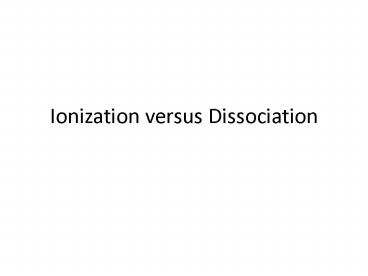Ionization versus Dissociation - PowerPoint PPT Presentation
1 / 21
Title:
Ionization versus Dissociation
Description:
Some very similar to ionization that happens to solids. ... Florine is the most electronegative atom because it is able to attract electrons ... – PowerPoint PPT presentation
Number of Views:100
Avg rating:3.0/5.0
Title: Ionization versus Dissociation
1
Ionization versus Dissociation
2
Ionization
- To remove a negative charge from a positive
charge. - The process of separating electrons from protons
is called ionization.
3
Dissociation
- Some very similar to ionization that happens to
solids. When the ions in a crystal lattice are
separated, the process is called dissociation. - Example sodium chloride in water.
- Dissociation occurs because of solvation, which
requires interaction of similarly electrical
properties.
4
Differences between Ionization and dissociation
- Ionization, the force comes from within the atom.
- Dissociation, the force comes from outside the
atom and is the interaction between two or more
compounds.
5
Ionic Compounds
- Ionization takes place to form solid ionic
crystals. - Example Sodium Chloride (Table salt)
- Positive sodium ions and negative chloride ions
- Ionic crystals can then interact with water
molecules to dissociate. - Resulting in a solution that conducts
electricity.
6
Microscopic Representation of Ionization
- Energy must be added to the neutral atom to
remove an electron from a proton. - The amount of energy depends on the type of atom.
7
Ionization is unique to the type of atom
- Each element has a characteristic ionization
energy. - Example Chlorine is 2.5 times greater than that
for sodium.
8
Importance in Understanding Ionization and
Dissociation
- Together these factors help explain important
macroscopic properties. - Solubility
- Hardness
- Conductivity
9
Electronegativity
- Covalent Bonds Bonding between atoms of similar
electrical properties. - Ionization is one way to quantify the electrical
properties. - Electronegativity is another way.
10
Electronegativity
- When two atoms of the same element bond they form
covalent molecules. - Covalent because they share electrons
- When two atoms of different element form covalent
bonds, the sharing might not be equal.
11
Why dont some atoms share equally?
- Atomic Structure
- Some atoms are better at attracting electrons
than others. - The ability to attract electrons is known as
electronegativity.
12
Linus Pauling
- An American chemist created a scale for
electronegativity. - He assigned Florine an arbitrary value of 4.
- Florine is the most electronegative atom because
it is able to attract electrons better than any
other element. - Electronegativity values for other elements where
created based on a comparison to florine
13
Electronegativity
- Can indicate the type of bond that will form.
- HOW?
- Think Tug-of-War
14
Atoms of the Same Strength (Covalent)
- There is no winner.
- The two atoms share the electrons equally with
each other.
Two atoms of similar strength
One or more electrons
15
Atoms of Somewhat Different Strengths (Polar
Covalent)
- One atoms pulls the rope more than the other,
neither wins. - More rope is to one side of the line
16
A Polar Covalent Bond
- Results in a molecule that has regions of
positive charge and regions of negative charge.
17
Atoms that have drastically different values
- The atom with greater electronegativity will win.
- Electron transfers from atom with low
electronegativity to an atom with high
electronegativity. - Ions are formed.
18
Atoms that have drastically different values
- The attraction between the two oppositely charged
ions is called an Ionic Bond
High electronegativity
Low electronegativity
One or more electrons
19
Indicating the bond type
Type of Bond Nonpolar Covalent Polar Covalent Ionic
Electronegativity difference lt 0.4 .4-2.1 gt 2.1
Diagram H----H H----Cl Na----Cl
Electrons Shared Equally Shared Unequally Transferred
20
Molecule vs Compound
- Both terms mean the same concept.
- Molecule is the smallest unit of a covalently
bonded compound. - Molecules are covalently bonded atoms
- Ionic Compounds
- Formed by ionic bonding
21
Assignment
- Write in your Planner or Table of contents!
- Ill be around to check before class is out.
- Page 135-139
- Reflect and Connect 1-4
- Due next class period































